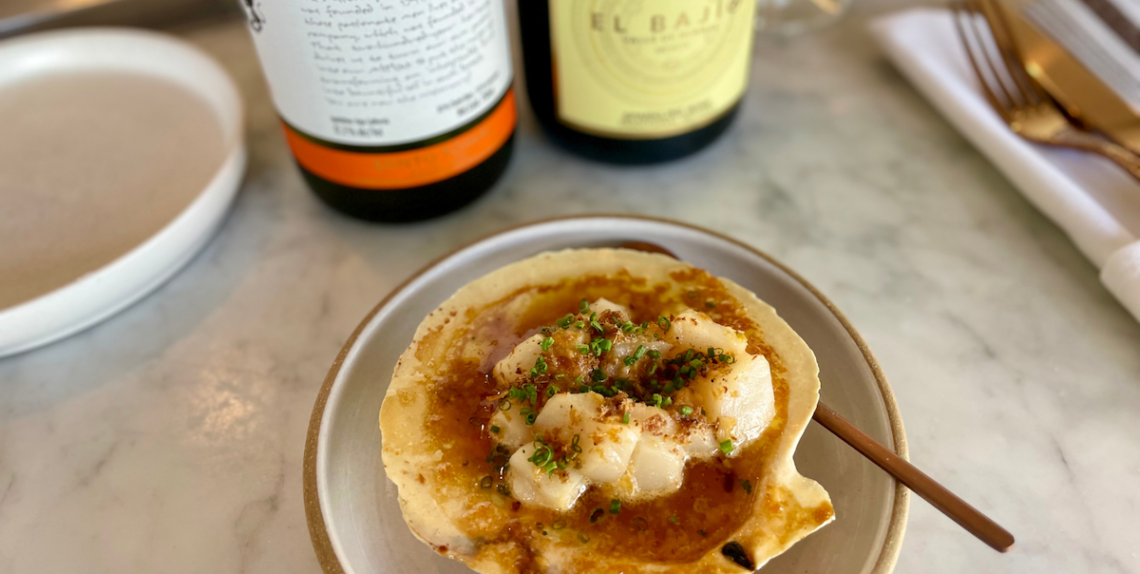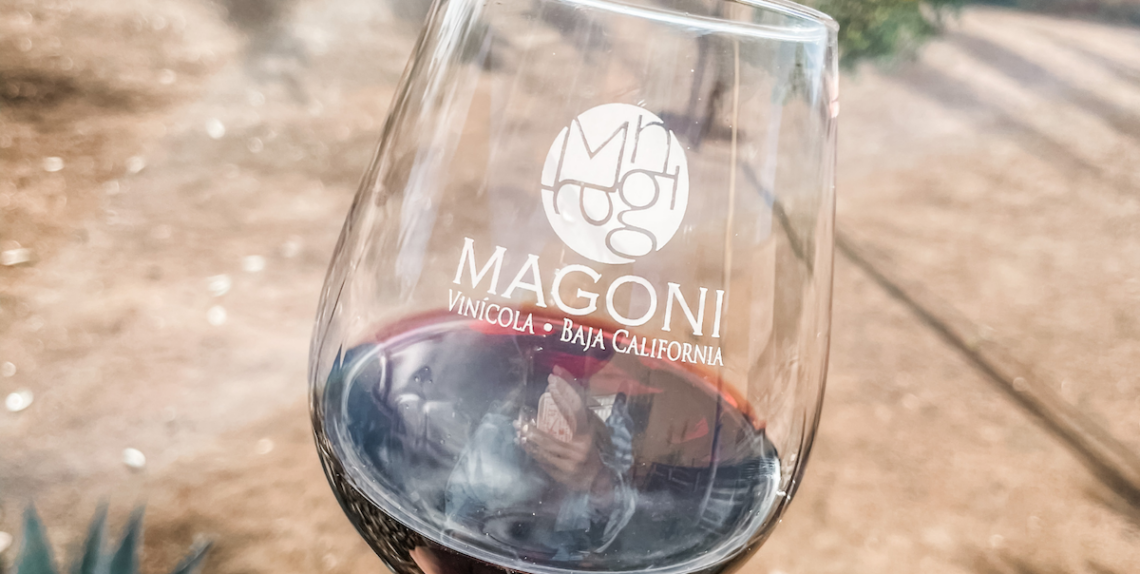
Mexican wine hasn’t quite met the mainstream drinking culture in Denver, but it’s time it should.
Mexico’s colors, flavors, unique ingredients, and hospitality are well-loved by foodies worldwide. For many of us, a trip south of the border brings notions of agave spirits, street tacos, and sandy beaches. If you’re a wine lover, chances are Mexico doesn’t pop up first of when planning an excursion to wine country. That may shift with this invitation to discover the burgeoning Mexican wine scene. Start the voyage here in Denver with a visit to one of Lohi’s newest eateries, Alma Fonda Fina.
The Magic of Alma Fonda Fina
Alma Fonda Fina has reimagined the tiny but intentional space at the corner of 15th and Umatilla Streets, previously occupied by The Truffle Table. Now it boasts a brilliant new aesthetic, complete with a chef’s counter and a menu of contemporary Mexican delights. For example, raw marine bites like Maine diver scallops ($21), adobo-seared Hamachi ($19), and Hawaiian Bigeye tuna ($19) served in a ginger-coconut aguachile.
From the land, dishes of adobo-braised lamb shank ($41), wild mushrooms ($17), and Colorado bass ($34) with habanero chile atole offer substance. The menu changes frequently, giving not only more reasons to return, but to showcase the season too. No matter the direction, the food is prepared with finesse and elegance with chef Johnny Curiel’s Mexican heritage woven throughout.
The restaurant’s name tells a story. Alma means soul in Spanish, and Fonda refers to the quaint neighborhood restaurants around Mexico. From the first time I heard the restaurant’s name, it brought to mind a favorite roadside eatery I’ve frequented during visits to Mexico’s Valle de Guadalupe. Fina calls out the elevated style expressed in every aspect of the restaurant.
The Hunt For Mexican Wine

This month, I set out to explore what Denver menus offer in Mexican wine. The task itself presented challenges. Across the city, Mexican restaurants and fusion chefs pair dishes with Spanish Albariño, Tempranillo, and the occasional Chilean Pinot Noir. The amount of California wine you’ll find on lists at Mexican establishments is disheartening.
I understand, sort of. Similar to the evolution of Colorado’s wine offerings, Mexico still has a way to go. If you visit Mexican wine country, and I hope you do, you’ll likely taste a few duds for every delicious drop you come across. The terroir, or aspects of the place that make the wines what they are is not ideal for wine grape cultivation. But like Colorado winemakers and growers, Mexican producers are learning to meet the vineyards where they are. They are letting the wines and the varieties they cultivate be what they want to be.
My hunt for a selection of Mexican wines I’m proud to share led me to the chef’s counter at Alma Fonda Fina. The wine list is compact and curated with full respect to the menu. Unlike some establishments that include a token Mexican wine but seem to have little faith in the merits of the juice, the team here tasted wines from countless producers to select options that align with the quality and experience offered throughout the program.
Alongside options from Mexico, well-placed bottlings from Sancerre to Vinho Verde to Cava and Argentine Malbec have their place. A few crowd-pleasers made the roster, too, since every good restaurateur knows that refusing to offer New Zealand Sauvignon Blanc or California Cab can be the nail in the coffin for some guests. A list like this has something for the adventurous and staples for the people who know what they like.
Glancing at the menu at Alma Fonda Fina, I saw crudo in my future. Inspired by the spectacular springtime weather, the direction made white wine the choice. Since dining out is a celebration in itself, bubbles are where I started. If you’re willing to immerse yourself in the full flavors of Mexico, let it include a taste of these remarkable wines.
El Bajio Brut

Made in the Bernal Valley in Querétaro, this region is within driving distance of Mexico City. In a traditional sense, this region’s proximity to the equator should make viticulture nearly impossible. However, with vineyards planted at elevations between 6,000 and 7,000 feet, the area enjoys a milder climate with cooling breezes. The exposure to the sun results in grapes with thicker skins that can withstand the rays. On the soil side, rocky and clay terrain provides the drainage necessary for wine grapes to thrive.
This sparkler blends 50-percent Macabeo and 40-percent Xarel-lo, a duo typically found in Spanish sparkling wines or cava. A little research reveals that the team behind the famed Spanish sparkling house, Freixenet, crafted the bottling. I perceive a 10-percent contribution from Ugni Blanc, a variety most often found in wines from the South of France, as a nod to the producer’s adaptation to the local terroir.
Like any sparkling wine worth its salt, El Bajio Brut is crafted using Méthode Champenoise, meaning each bottle gets a second fermentation to produce the bubbles. This differs from, say, Prosecco, which gets its bubbles in a large tank. The wine rests for 18 to 24 months sur lie (in contact with the dead yeast cells from the fermentation), imparting the bready characteristics associated with top-quality champagne.
The bubbles are tiny in the glass, and the blend produces fresh citrus and orchard fruit aromas with a floral note. To pair, I savored the Callo de Hacha Al Horno, a dish of Maine diver scallops, serrano ponzu, tomato butter, and chive. If given the option, I would indulge in this combo weekly.
Bodegas de Santo Tomás Misión Blanco 2021
For the next dish, I opted to stay with white, sans the bubbles. Enter the Misión Blanco from Bodegás Santo Tomás. For more than 135 years this producer has crafted quality wines in Baja California. A trailblazer in the industry, it was the first winery established in the region and the first in Mexico to appoint a female head winemaker, Laura Zamora.
The Misión Blanco, a blend of Chenin Blanc and Colombard, offers a delightful twist on two classic French varieties. It delivers a satisfying weight on the palate and the honeyed notes I adore in Chenin Blanc.
Visit Mexican Wine Country

With tasting rooms open to visitors in Valle de Guadalupe, Ensenada, and Santo Tomás, there are multiple options for those looking to include an in-person experience of Mexican wine tourism in their next trip.
If you’re interested in incorporating the wines of Mexico on an upcoming trip itinerary, start closer to home. A quick hop over the border at Tijuana and a drive down the breathtaking coastal highway brings you through the surf town of Rosarito. Continuing south, you’ll reach the town of Ensenada for a total drive time of about two hours from San Diego.
Whether venturing south to Mexico or starting local, explore the wines of Mexico. The next time I’m in Lohi, I plan to taste the Nebbiolo from Casa Jipi at Alma Fonda Fina.
Visit Alma Fonda Fina daily at 4 p.m. and until 10 p.m. Sunday through Thursday, and 11 p.m. Friday and Saturday. There’s also a weekday happy hour from 2 to 4 p.m. 2556 15th St.. Denver, almalohidenver.com
About The Author
Montana Rae
Montana Rae is a CMS Certified Sommelier and WSET Level III residing in Denver, Colorado. She offers private wine tastings, classes, and dinners at clients’ homes and businesses around Colorado, as well as product recommendations, tips, recipes, and more through her company, The Wine Ship.
Montana is also a commercial real estate broker specializing in sales and leasing of restaurant and retail spaces in Denver.
Contact Montana at montana@thewineship.com and follow her on Instagram @montana.rae.sommelier




Comments are closed.